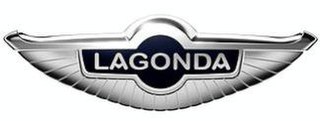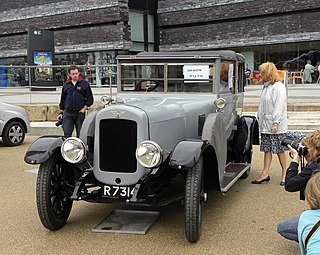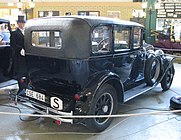
The Duett is an automobile from Volvo that was in production from 1953 until 1969.

Singer Motors Limited was a British motor vehicle manufacturing business, originally a bicycle manufacturer founded as Singer & Co by George Singer, in 1874 in Coventry, England. Singer & Co's bicycle manufacture continued. From 1901 George Singer's Singer Motor Co made cars and commercial vehicles.

The Volvo PV800 Series is a taxicab manufactured by Volvo from 1938 until 1958. The Sow series dominated the Swedish taxicab market during the 1940s and 1950s.
The Morris Isis name was first briefly used by Morris Motors Limited on a 6-cylinder car made from 1929 until 1931. It was resurrected on a new 6-cylinder midsize car from the British Motor Corporation in the 1950s to replace the Morris Six MS.

The Austin 7 is an economy car that was produced from 1923 until 1939 in the United Kingdom by Austin. It was nicknamed the "Baby Austin" and was at that time one of the most popular cars produced for the British market and sold well abroad. Its effect on the British market was similar to that of the Model T Ford in the US, replacing most other British economy cars and cyclecars of the early 1920s. It was also licensed and copied by companies all over the world. The first BMW car, the BMW Dixi, was a licensed Austin 7. In France they were made and sold as Rosengarts, and in the United States they were built by the American Austin Car Company. In Japan, Nissan also used the 7 design as the basis for their first cars, although not under licence. This eventually led to a 1952 agreement for Nissan to build and sell Austins in Japan under the Austin name.

Lagonda is a British luxury car brand established in 1906, which has been owned by Aston Martin since 1947. The trade-name has not had a continuous commercial existence, being dormant several times, most recently from 1995 to 2008 and 2010 to 2013.
Morris Cowley was a name given to various cars produced by Morris from 1915 to 1958.

The Volvo ÖV 4 was the first car built by Volvo. The designation ÖV 4 stands for "Öppen Vagn 4 cylindrar" in Swedish, which means Open Carriage, 4 cylinders. The model ÖV 4 has later often been referred to as "Jakob" but that was just a name for one of the 10 pre-series ÖV 4 that was ready on 25 July 1926, Jakob's name day. All 10 prototypes were assembled in Stockholm at the company AB Galco, Hälsingegatan 41 where Gustaf Larson worked at that time. Only one of the 10 pre-series cars manufactured during 1926 was saved for posterity and is housed at the Volvo Museum in Gothenburg, Sweden.

The Riley Nine was one of the most successful light sporting cars produced by the British motor industry in the inter war period. It was made by the Riley company of Coventry, England with a wide range of body styles between 1926 and 1938.

The Volvo PV51 is a car introduced by Volvo in December 1936. It was replaced by the mildly restyled PV53 in 1938. This car remained in production until the end of the Second World War.

The Singer Bantam is a car which was produced by Singer from 1936 to 1939. It was the first model from Singer to have an all-steel body, by Pressed Steel Company. It was offered as a new economy model at the 1935 Motor Show in London, replacing the earlier Singer Nine series.

The Rover 10 was a small family car from the British Rover car company produced between 1927 and 1947.

The Wolseley Hornet is a six-cylinder twelve fiscal horsepower lightweight automobile which was offered as a saloon car, coupé and open two-seater as well as the usual rolling chassis for bespoke coachwork. Produced by Wolseley Motors Limited from 1930 until 1936, the Hornet was unveiled to the public at the end of April 1930. Wolseley had been bought from the receivers by William Morris in 1927.

The Lancia Artena is a passenger car produced by Italian car manufacturer Lancia from 1931 until 1936, and from 1940 until 1942 chiefly for army and government use. It was powered by a 2-litre Lancia V4 engine, while chassis and factory bodies were shared with the more luxurious 2.6-litre V8-engined Lancia Astura. Total production amounted to 5,567 examples.

The Austin Light Twelve-Six is a 14 tax horsepower car with a 1496 cc engine that was introduced by Austin in January 1931. It was named by Austin Light Twelve to separate it from the well-established Austin Twelve. The general public then dubbed the original Twelve Heavy Twelve but Austin never used that name. The Light Twelve-Six remained in production until 1936.

The Volvo TR670 Series was a taxicab manufactured by Volvo between 1930 and 1937. The model name stands for TRafikvagn ("taxicab"), 6 cylinders, 7 seats; the third digit indicates the version.

Austin Twenty is a large car introduced by Austin after the end of the First World War, in April 1919 and continued in production until 1930. After the Austin 20/6 model was introduced in 1927, the first model was referred to as the Austin 20/4.

The Škoda Popular is a small family car that was made in Czechoslovakia by Škoda from 1933 to 1946. It was the company's most affordable car at the time.

The Austin Eighteen is a large saloon car, supplied in two different wheelbases to carry five or seven passengers, that was introduced by Austin on 14 July 1937. Its engine and front seat were mounted nine inches further forward than on the old York Sixteen it replaced. The chassis was also extended three inches to provide a total of twelve inches more passenger space. One result was a relatively short bonnet and a good driving position. Its new shape followed the lines of the other Austin cars introduced the previous autumn and it was remarkable for having a completely flat floor in both front and rear passenger compartments with exceptionally wide doors and draught-free ventilation.
























